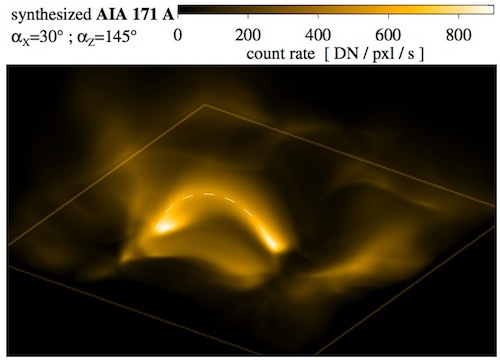
We employ a three-dimensional magnetohydrodynamics (3D MHD) model of the corona. The heating of the coronal plasma is the result of braiding of the magnetic field lines through footpoint motions and subsequent dissipation of the induced currents. From the model we synthesize the coronal emission, which is directly comparable to observations from, e.g., the Atmospheric Imaging Assembly on the Solar Dynamics Observatory (AIA/SDO).
We find that the synthesized observation of a coronal loop seen in the 3D data cube does match actually observed loops in count rate and that the cross section is roughly constant, as observed. The magnetic field in the loop is expanding and the plasma density is concentrated in this expanding loop; however, the temperature is not constant perpendicular to the plasma loop. The higher temperature in the upper outer parts of the loop is so high that this part of the loop is outside the contribution function of the respective emission line(s). In effect, the upper part of the plasma loop is not bright and thus the loop actually seen in coronal emission appears to have a constant width.
From this we can conclude that the underlying field-line-braiding heating mechanism provides the proper spatial and temporal distribution of the energy input into the corona - at least on the observable scales.
View of the modeled corona above an active region as would be seen by AIA/SDO in the 171 Å channel dominated by emission from below about 106 K. The rectangle indicates the boundaries of the computational domain (50x50x30 Mm) at the coronal base. The most prominent loop connects the periphery of the two magnetic concentrations at the surface (not shown here) and has a roughly semicircular shape with about 30 Mm length. In the vicinity of the active region, hazy emission can be seen that is associated with the diffuse background corona in the quiet Sun. The white dashed line indicates the position of a loop shown in the figure below. The temporal evolution over 50 min is shown in a movie available when clicking on the image.

More inforation can be found in the following publication:
Constant cross section of loops in the solar corona
Peter H., Bingert S. (2012) A&A 548, A1
Link to ADS
Structure of solar coronal loops: from miniature to large-scale
Peter H., Bingert S., Klimchuk J.A., et al. (2013) A&A 556, A104
Link to ADS